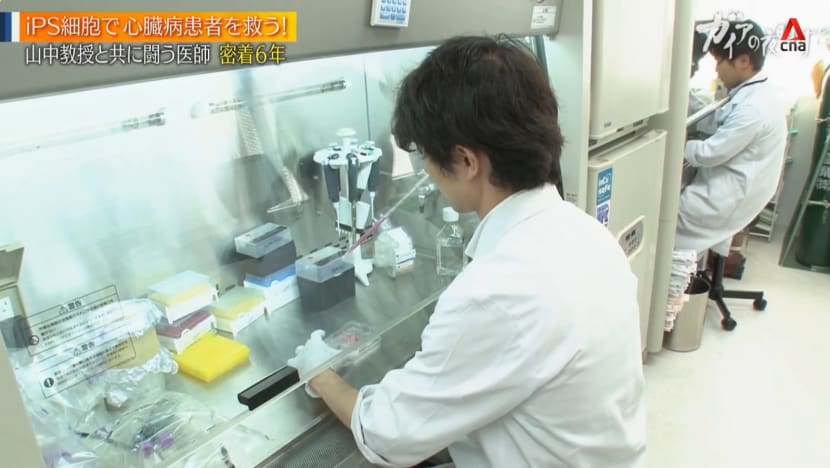Gaia Series 18 : New Treatment Using iPS Cells
Induced pluripotent stem cells (iPS cells), the work of Nobel Prize laureate Dr Shinya Yamanaka, are featured; we discover how heart muscle sheets made from such cells can benefit heart patients.


This audio is generated by an AI tool.
This week, we focus on the work of Professor Shinya Yamanaka, who won the Nobel Prize for Physiology or Medicine in 2012. The scientist and physician from Kyoto University won the accolade for his groundbreaking research on induced pluripotent stem cells (iPS cells). Such cells revert to a state where they can become anything. So iPS cells can grow into other cells within the body. These cells can be used to generate internal organs and tissue as well as recover competencies lost through accident and illness. Japan is seen as a world leader in research into iPS cell therapies.
The second most common cause of death in Japanese people is heart disease. So a doctor who teamed up with Professor Yamanaka sought to create heart muscle from iPS cells. The researcher involved in this is heart surgeon Yoshiki Sawa from Osaka University. One of the world’s most advanced research institutes for iPS cells is located at Osaka University. It is here where iPS cells are cultivated. Each iPS cell is created from human cells and iPS cells can change properties. They are put into tanks after which special proteins and other substances are added. It takes about a month to cultivate them. They are then used to develop a heart muscle. Dr Sawa’s aim is to transplant a heart muscle sheet, made from iPS cells, onto a weakened heart and restore functionality.
In 2018, Dr Sawa started cultivating cells that may be administered to a heart patient. After years of research, he worked on creating a heart muscle sheet made from iPS cells. In May 2018, the Ministry of Health, Labour and Welfare gave conditional approval for clinical studies on transplanting iPS cells. Dr Sawa thus could finally start on regenerative therapy using a heart muscle made from iPS cells. Osaka University Hospital later successfully conducted three heart sheet transplant trials. In September 2021, numerous facilities across Japan started carrying out clinical trials on the heart cell sheet.
One of the hospitals involved in the trial is Kyushu University Hospital in Fukuoka. In January 2023, a patient chosen for the trial underwent the procedure at the hospital. Mr Yamada (not his real name) is in his 50s and has ischemic cardiomyopathy. The procedure using a heart muscle sheet made from iPS cells was carried out by the Department of Heart Surgery. Dr Sawa from Osaka was also present. The heart muscle sheets made from iPS cells were transported from Minoh City, Osaka, where they were manufactured at a firm, CUORiPS Inc, which was founded by Dr Sawa in 2017.
Before the surgery, Dr Sawa checked the heart muscle sheet from Osaka. If you look at it under a microscope, it moves just like a real heart. There are more than 30 million heart cells in one sheet. The transplant of the heart muscle sheet created from iPS cells was performed by Professor Akira Shiose from Kyushu University, with Dr Sawa assisting. Three sheets, with nearly 100 million heart cells, were attached during the procedure. The sheets covered Mr Yamada’s weakened left ventricle, restoring the heart's ability to pump blood around the body. The operation, which took about one hour, went off without a hitch. Four months after the surgery, Mr Yamada came to Kyushu University Hospital for a follow-up to make sure the heart muscle was doing its job. He was reviewed by Dr Sawa and eventually returned to work later in May.
Dr Sawa finally completed the clinical trials using the heart muscle sheets in transplants. In early 2024, he plans to apply for certification for the iPS cell heart transplant muscle transplant.
Meanwhile, at the University of Tokyo's Institute of Medical Science, a new type of research using iPS cells is being carried out. Professor Hideki Taniguchi has created a "miniature liver" created from human iPS cells. It consists of about 15,000 mini livers. The ultimate goal is to produce livers from iPS cells for use in liver transplants.
We return to Kyoto City, where I Peace Inc. has its headquarters. It is also engaged in research in iPS cells with Professor Yamanaka. Founded in 2015, it has 35 employees and its CEO is Koji Tanabe. It offers a service for individuals to personally create and store iPS cells of sufficient quality to use in treatments in the future. Most of the iPS cells are provided by a foundation headed by Professor Yamanaka. Mr Tanabe developed a service to enable people to have their own personal iPS cells or a personal iPS bank service.
One of its customers is Mr Setoyama, a business manager. He visits a clinic operated by I Peace Inc. in Shibuya Ward, Tokyo. To get the cells, one needs a blood sample, which is then taken to an I Peace facility in Kyoto City. In the clean room, the blood is separated, they take out the blood cells and make the individual iPS cells. It takes 2.5 months to cultivate them separately. The staff then increase the number of cells by approximately 100,000, after which they are stored in freezers at approximately -180 degrees Celsius. Mr Tanabe also spent five years creating a machine that creates iPS cells without the need for human intervention.
Currently, four facilities provide the personal iPS cell banking services and Mr Tanabe aims to increase this to 50 within five years. Mr Tanabe visits clinics throughout Japan to look for doctors to collaborate with in this endeavour.
Tips:
1) The potential of iPS cells is expanding to benefit more organs and even drug development
2) I Peace Inc. offers an iPS bank service to people who want to store their own personal iPS cells












